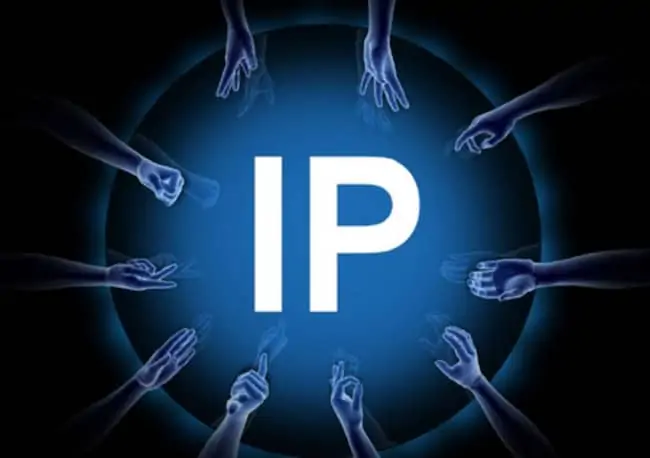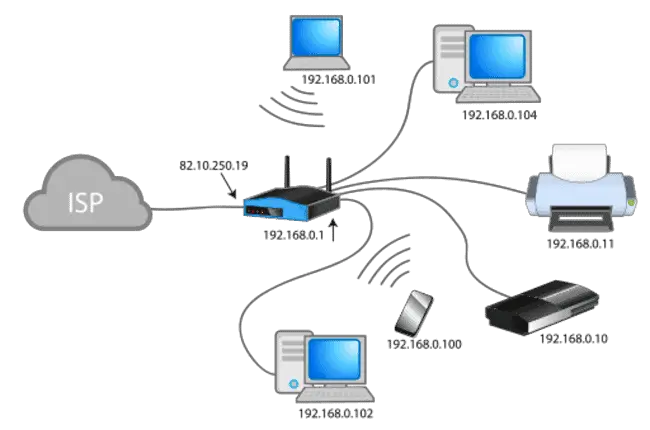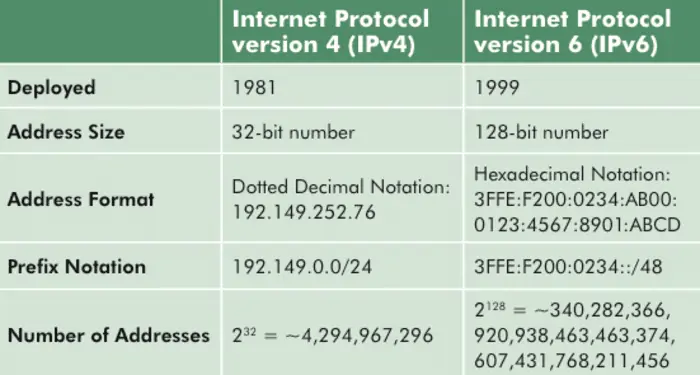Many computer savvy people may have noticed that there are actually now two types of Internet Protocol (IP) addressing – IPv4 and IPv6 addressing, version 6 being a more modern standard. What is the difference between these two versions and why does IPv6 addressing exist?
IPv6 addressing has been introduced as in today’s modern connected world there are not enough addresses in the IPv4 range to accommodate all the connected devices. IPv6 is a broader, more spacious and efficient addressing system that can accommodate far more devices more effectively and as it grows IPv4 addressing will slowly be phased out.
Let’s look at the issue in more detail below.

There are too many devices in the world now for each device to have an unique IP address under the IPv4 scheme, hence the introduction of the more spacious IPv6 address scheme
The Problem With IPv4
IPv4 addressing has been around for several decades and will still be around for some time; it will just be slowly phased out and replaced by IPv6. IPv4 addresses are the standard IP addresses that most people will be familiar with – the four sets of numbers separated by dots in the xxx.xxx.xxx.xxx format.
Each set can take any value from 0 to 255. A common and recognisable address written in this format is the address to log in to a router – 192.168.0.1 or 192.168.1.1
With 256 different values available for each quartet of an IP address, then the total number of IPv4 addresses available is 256 to the power 4, which comes out at just under 4.3 billion unique IP addresses available under this addressing scheme.
Whilst this may sound like a lot and was indeed sufficient in the early days of the internet, the reality is that in todays world it is far too small a range of IP addresses for all the devices in the world to have a unique IP address. Remember that every device that sends or receives information over the internet must have an IP address; this includes phones, tablets and other portable devices.
The current number of internet connected devices globally is easily over 10 billion, and is set to reach more than 24 billion by 2020, so in today’s “Internet of Things”, where more and more devices have an ability to connect to the internet and each other, 4.3 billion addresses in nowhere near enough for each individual device to have a unique IP address not shared by another.
The last block of fresh IPv4 addresses was issued in 2018.
Network Address Translation (NAT) To The Rescue
This is where NAT or Network Address Translation comes in to help solve the problem of limited IPv4 addresses. It maps public IP addresses, which are unique, to private IP addresses on a home network, which are interchangeable and often come in the 192.168.0.x range, with x being a specific number up to 255 assigned by the router to each device in a household.
These CAN be generically over the same range between houses as routers and firewalls secure and enclose these private home networks off from other home networks.
So NAT effectively allows each house/router, rather than each device, to have a unique outer IP address by translating the public IP address to a private (home) IP address and then assigning different sub-addresses to different devices over this private range.
When a router receives a piece of data from the internet, it takes the public IP address (eg 82.10.250.19 in the diagram below) and translates it into a private IP address and range (192.168.0.1-255) and forwards the data onto the device it was intended for in this private address range.
Each device is differentiated by having a different number assigned to it for the last bit of the private IP address, up to 255.

Image credit – Wikipedia
NAT or Network Address Translation solves the problem of there not being enough unique IPv4 addresses by mapping public IP addresses to private (home) IP addresses
IPv6 Solves This Problem
The newer IPv6 protocol solves this problem by providing a much larger range of addresses. An IPv6 address uses different notation – 4 lots of 4 different numbers or digits, separated by colons, for example: 2001:0DB8:AC10:FE01.
The mixture of numbers and letters produces a much larger pool of possible unique combinations. The total possible number of unique IPv6 addresses is staggering, roughly 340 undecillion or 2 to the power 128, which is about as many grains of sand as there are on earth. It is safe to sat there are more than enough IPv6 addresses for every device in the world for a long time to come!
IPv4 vs IPv6 – Quick Comparison

Benefits of IPv6 over IPv4:
- More address space
- Simplified packet structure
- Larger payload for increased throughput and transport efficiency
- Hierarchical network for routing efficiency
- Eliminates the need for NAT
- In general runs cleaner, smoother and more efficiently than IPv4
The main benefits of IPv6 are summarised above, but in general it just runs as a cleaner, simpler, more streamlined version of IPv4. IPv6 data packets have been cleaned up relative to v4, with some parts of packets removed or merged with others for a more efficient structure, which should ultimately lead to better data transfer and connectivity.
The massive address space is obviously the biggest bonus, as even the progression of connectivity to the Internet of Things is still not finished yet even with the growth or phone and tablet connectivity. Even more devices such as fridges, cars, and other home appliances look set to be connecting to the internet more and more as time goes on.
A knock on benefit of the almost unlimited address space of IPv6 is also that it eliminates the need for NAT, as under IPv6 there would be no conceivable shortage of unique IP addresses even for every device in the world.
Even with a world population of 7 billion, every single person having 10 connected devices would still use only a tiny fraction of the 340 undecillion available IPv6 addresses.
With no need for the NAT middleman translating public IP addresses into private ones as in IPv4, end to end connectivity is improved under v6. This will be of benefit to all users but particularly to online gamers, who rely on speedy and efficient end to end connectivity for a smooth online experience.
Currently under IPv4, NAT issues are a common cause of connectivity issues for gamers.
Hopefully the next generation of games consoles will be IPv6 enabled, which will do away with the need for NAT and any connection issues it brings with it. IPv6 enabled consoles should be able to communicate more freely with each other for smoother online play.
How Long Before IPv6 is Fully Phased In?
Despite all the benefits of IPv6 over IPv4 we have mentioned, it is still true that IPv4 is the most dominant protocol at the moment across most of the world. Fully phasing in IPv6 to the point where IPv4 is fully obsolete will likely take many more years, as it takes a long time to get everyone moved over to the “new form” of anything in technology.
Operating systems, software coding, and numerous other things have to all be re-written and re-configured to allow for this new form of connecting devices across the internet, plus the fact that for obvious reasons both devices have to be able to use IPv6 to connect in this way (as the name says it’s a protocol – and for protocols to work, both sides/ends need to know what the rules are).
This doesn’t happen overnight, but newer devices are being equipped to handle IPv6 if the user chooses to configure them that way. There will be an inevitable lengthy transition period until we can say all devices on the internet are built to use IPv6 by default, and IPv4 is fully obsolete. For now, IPv6 connectivity remains a background option that can sometimes be used when both devices allow.
So whilst there are many devices that can use IPv6 addresses; it just can’t quite be classed as the default just yet. There are many devices that still use IPv4 and NAT for connectivity to other devices across the internet.
